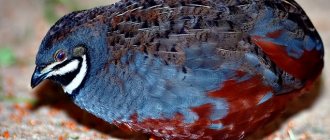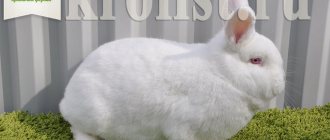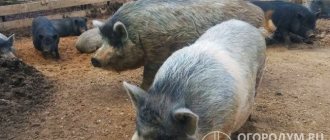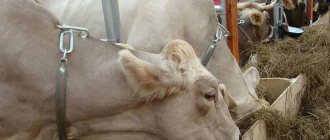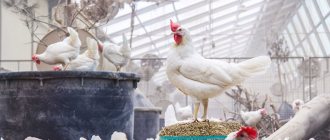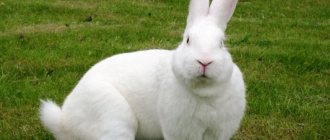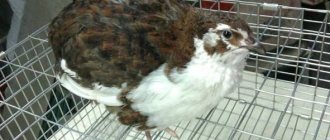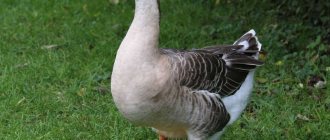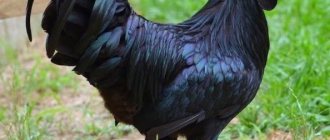Home » Articles about quail » Texas white quail
Texas white quail, another name for which is “white pharaoh”, are broiler birds with high meat productivity. They are the largest and heaviest representatives of their species. Texas quails are not particularly difficult to keep, so they are suitable for growing both in industrial and home conditions.
Appearance
The body constitution of the white pharaoh is typical for broilers. The body of such a bird is dense and muscular, with a prominent chest and a wide back. “Texans” gain weight in a short time, but if they eat too much they can become obese.
It is quite easy to distinguish representatives of the breed from other quails by their appearance, thanks to their white plumage. The standard allows for a small amount of black speckling, but birds of one color are given priority.
How to distinguish a female from a male
It will be difficult for an inexperienced poultry breeder to determine the gender of young animals by voice and nuances of appearance, as professional breeders can. It is better to use a universal method that allows you to identify males by the presence of a cloacal gland.
To do this, turn the bird upside down with one hand, and probe the cloaca with the other, spreading the feathers under the tail. The tubercle, which releases a white, foamy secretion when lightly pressed, is the same sex gland that is found only in cockerels.
Productivity
When breeding the white Texas breed, Japanese and English white birds, as well as representatives of other varieties, were used. It was from the “English” that the Texas pharaoh received a snow-colored outfit and high meat productivity. The final characteristics of the Texas White quail are as follows:
- the body weight of an adult laying hen is from 400 to 450 g, and the weight of a male is from 300 to 360 g;
- meat yield at slaughter – at least 250 g;
- egg production - 120-160 pcs. in year;
- egg weight - from 12 to 14 g.
Record-breaking individuals can weigh up to half a kilogram, and sometimes more, but such birds are considered unsuitable for breeding. The Texas quail carcass has an excellent presentation. Its flesh is light, and its skin has a pleasant yellowish tint.
The nutritious white pharaoh meat contains more than 20 vital microelements and vitamins, with a minimum of cholesterol. It is ideal for children's menus, as well as for those who suffer from allergies, pathologies of the cardiovascular system and digestive organs.
Characteristic
Texas quails first appeared in America. Their ancestors were the best representatives of the Japanese and English quail breeds. The birds inherited their white color from their English relatives, and they inherited good egg production from the Japanese breed. Other names for large Texans include:
- snow (Texas) pharaoh;
- albino broiler;
- white (Texas) giant.
The names indirectly indicate the surprisingly large weight of the bird or the snow-white plumage that is different from other quails, which is immediately noticeable in the photo of the Texas quail breed.
Content
To house hundreds of birds you will need a barn or room with an area of 10 to 15 m2. Texas quails are kept in cages measuring 0.4 m x 0.9 m, with a ceiling height of no more than 0.2 m. Given the large dimensions of white pharaohs, each bird should have at least 0.4 m2 of space. When forming families, 2 females are placed with the male.
It is better not to install feeders and drinkers inside, but to secure them on the outside of the cage. The mesh or lattice along the facade must have gaps or cells sufficient for the bird to easily stick its head through, but not its entire body. Trays are placed on the floor for collecting eggs and droppings, which should be emptied and cleaned in a timely manner.
Texas whites are healthy and therefore resistant to infections. However, when kept in unsanitary conditions, they get sick and lose productivity.
When raising quails, it is important to remember to maintain the correct microclimate. These birds cannot tolerate drafts, but the room must have good ventilation. As for the lighting, it cannot be bright, and direct sunlight on the cage with birds is generally unacceptable. For the same reason, it is better to place houses away from lamps.
The optimal room temperature is considered to be from +18 to +22C. To make birds comfortable in winter, heating with electrical appliances will be required. It is also important to monitor the humidity level, which should be maintained at 55-65%. To prevent the air from drying out, containers with water are placed near the cells.
Lighting
Quails prefer dim lighting. Bright light causes them anxiety and stress, as a result, egg production decreases, cannibalism and egg pecking begin. For a small poultry house, one 40 W lamp is enough; in a large room, several 25 W devices are placed.
Quail egg production is highly dependent on lighting
In order for the quails to lay eggs, the daylight hours are maintained at 17 hours. Reducing the lighting regime leads to a decrease or absence of egg production and a decrease in the amount of food eaten. An artificial increase in daylight hours is the cause of excessive consumption of feed, rapid exhaustion of laying hens, anxiety and fights in the bird family.
Feeding
The diet of white Texas pharaohs is standard for meat quails. Each adult consumes 35 g of food daily. Thanks to their good appetite, young birds gain enough weight to sell by the age of one and a half months. Highly productive laying hens are usually kept for up to 7-8 months.
When feeding white Texas broilers, it is better to use ready-made diets, which can be purchased in specialized stores, as well as on the Internet. Farmers do just that, because these formulations are ideal in terms of the content of proteins, fats, carbohydrates, minerals and vitamins. The following are used as basic components:
- crushed corn grain;
- wheat and barley;
- bran and various feed additives.
About a third are components containing animal protein, namely fish and meat and bone meal, and soybean meal.
If necessary, food for quails can be made independently, from the same products as in ready-made diets. Additionally, birds are given:
- fresh herbs;
- pumpkin and zucchini;
- beets and carrots;
- cabbage
For intensive fattening, boiled peas are used, meat and fish broths, as well as minced meat are mixed into the grain mixtures.
Light mode
Immediately after hatching and transplanting into the brooder, 24-hour lighting should be provided.
To prevent pecking and increased nervousness, brightness for adult Texas quail is limited. Twilight will be enough, and light is needed only for the feeding and drinking area. Direct sunlight is contraindicated.
It is not recommended to use bright lamps to heat the brooder, because the chicks can get burned on the hot surface. The best option is ceramic lamps.
Breeding
Texas quail have a calm, even apathetic character. Everything would be fine, but this negatively affects the sexual temperament of males. That is why only 2 chickens are added to each of them, and not 4-5, as for representatives of other breeds.
Females begin to produce their first eggs at the age of 1.5-2 months, but are not capable of incubation. Therefore, to produce offspring using your own livestock, you will need an incubator, although a more profitable option is to purchase chickens externally.
Eggs for incubation are collected within 7-10 days. It is important to remember: the older the material, the lower the hatchability. If up to 80% of chicks can be obtained from seven-day-old eggs, then only about 60% from 10-day-old eggs.
A standard incubator equipped with a tray for small eggs is suitable for hatching quails. The chicks hatch on 16-17 days.
Incubation
The largest eggs, which often have two yolks, are only suitable for food. For incubation, medium-sized eggs from females no older than 10 months are selected. It is not advisable to store eggs for longer than 5 days before incubation, as the hatchability rate will decrease. The incubation process is standard.
The hatched chicks are left to dry in the incubator for 12 hours. The quail are kept in a brooder for several weeks, lowering the temperature by 0.5 degrees every day from 37 to 22, after which they are transferred to cages for adult birds.
Caring for young animals
In order to ensure maximum safety of young livestock, they should be properly cared for. Dried chickens are transferred from the incubator to a brooder or a warm cardboard box. To maintain optimal air temperature - from 33 to 35C, heater lamps are used. Humidity is kept at 60-70%, and the room is periodically ventilated.
As soon as they are born, small broilers require food. They are given finely chopped boiled eggs, and after 1-2 days cottage cheese is added at the rate of 2 g per individual. After another 1-2 days, corn grits are added to the menu, as well as fresh herbs.
Chicks older than 1 week are gradually accustomed to ready-made broiler feed, and after another 7 days they are completely transferred to the diet of adult birds.
The photo of a Texas white quail that has reached sexual maturity shows that it is well-fed and quite ready for slaughter. Before the birds are released for meat, the best laying hens and cockerels are left for breeding, and the working flock, if necessary, is transferred to intensive fattening. Individuals of different sexes are housed in separate cages. They are given high-calorie grain diets, with the addition of peas, nuts and other nutritional components rich in protein.
What to feed?
The Texas Giants are famous for their excellent appetites. To gain weight quickly, your diet must be balanced. One quail eats up to 40-50 g of feed per day, that is, for a population of 100 birds you will need up to 4-5 kg of feed per day. Industrial high-quality feed is purchased for them.
Unlike chickens, quails immediately begin to eat food for adult birds, only in a more crushed form. But to accelerate the rate of weight gain, they are fed according to the following scheme:
- First, hatched quails are given food rich in proteins:
- chopped boiled eggs;
- cottage cheese rubbed through a fine sieve;
- fermented milk products - yogurt, kefir.
- Next, greens, finely ground crackers, and food for the chicks are introduced.
- For older chicks, feed is added, as well as foods rich in calcium - chalk, shells, crushed shells and bone meal.
- The menu of females that have begun to lay eggs must include crushed raw sea fish and salt.
Birds should always have fresh water at room temperature in their drinking bowls from birth so that they can drink freely at any time.
Where to Buy White Texas Quails
It is better to turn to trusted breeders who have been dealing with meat quail professionally for a long time and have a high business reputation. It doesn’t hurt to first read customer reviews and, if possible, talk to them in person.
If you buy birds at the market, you should take into account that there is a high risk of buying a crossbreed of dubious origin that does not have the required productivity. One of the signs of this is the greatly reduced price of the bird, despite the fact that the Texas white breed of quail is popular and its cost is considerable.
Diseases
Texas quails do not have strong immunity, so many poultry farmers practice feeding them with vitamins starting from the age of three days. If maintenance standards are violated, cannibalism (pecking) and feather loss may occur.
Pecking
Birds behave restlessly and cause damage to each other, most often in the head area. This may be due to crowded content and too bright lighting. Sick birds are removed from the flock and the problem usually disappears once conditions return to normal.
Feather falling out
When feathers fall out in quails, bald patches (unfeathered areas of skin) appear on the back and head, and the remaining feathers become brittle. The reasons are drafts and low air humidity (less than 50%). For prevention, B vitamins are added to the diet.
- Parasites
- Infectious
- Other
Worms (helminths)
Roundworms that cause various diseases and, as a result, serious disorders in the body of birds
Read
Pere-eaters
How to deal with them using folk methods? How can I prevent parasites from appearing again?
Read
Mite
Diseases caused by the parasite. Symptoms, treatment, recommendations for prevention
Read
Newcastle disease (pseudoplague)
What is it and how to avoid infection? Main characteristics of the disease
Read
Pullorosis
Description of the disease, symptoms, treatment, preventive measures
Read
Aspergillosis
An infectious disease that affects the respiratory organs and leads to the death of the bird
Read
Psittacosis
Disease with severe respiratory disorders
Read
Salmonellosis
Symptoms of acute and permanent forms of the disease, treatment and prevention
Read
Colibacillosis
How to identify the source of the disease, how to cure a sick bird and immediately take preventive measures?
Read
Smallpox
Causes, symptoms of various forms, preventive measures and treatment methods
Read
Pecking
How does behavior disorder manifest itself, why is pecking dangerous and how to eliminate it?
Read
Rickets
A chronic disease characterized by impaired calcium-phosphorus metabolism
Read
Inflammation of the oviduct (salpingitis)
An inflammatory disease that can be effectively treated in the early stages. How to cure and restore egg laying?
Read
Advantages and disadvantages of the breed
Concluding the description of the Texas white quail breed, we can highlight its main advantages and disadvantages. Among the first:
- rapid ripening;
- rapid weight gain;
- excellent consumer qualities of meat and eggs;
- housing conditions and diets standard for broiler quails;
- excellent presentation of the carcass.
The second, although very conditionally, include:
- low egg production;
- a small percentage of fertilized eggs;
- high feed consumption.
Speaking about the absolute disadvantages of the breed, we should mention such as the weak sexual activity of males and the lack of brooding instinct in females.
Valuable advice
Beginning poultry farmers often face problems when choosing and purchasing quails. The advice of experienced farmers who have been breeding representatives of the Texas breed for many years will help you understand all the nuances:
When choosing, it is recommended to pay attention to the color of the chicks. Preference should be given to individuals that have no more than three dark spots in their plumage. Before purchasing, you should take care of where Texan quails live.
It is necessary to prepare spacious cages to ensure a comfortable existence for pets. Representatives of the breed have weaker immunity compared to egg and mixed varieties. It is recommended to feed three-day-old chicks with vitamin preparations (Chiktonik) to strengthen the body’s defenses. It is impossible to determine the sex of Texan chickens. Sex differences will only be visible at 50–55 days of age. Therefore, it is impossible to calculate the sexual composition of the flock in advance. To distinguish a male from a female, you need to examine the genitals of the bird. In quails, the cloaca has the appearance of an elongated slit; in quails, the genitals are rounded; with light pressure, a light, foamy liquid is released from them. Those who independently breed Texans need to take care of the quality of the livestock. Individuals with defects in paws or beaks are rejected and slaughtered or put in a separate cage so as not to be allowed into breeding.
Texas white quail have several disadvantages, which are offset by one advantage - greater weight. The farmer needs to provide the livestock with spacious cages and a nutritious diet, and organize appropriate living conditions. In return, he will receive a lot of tender, tasty dietary meat in a short time.
